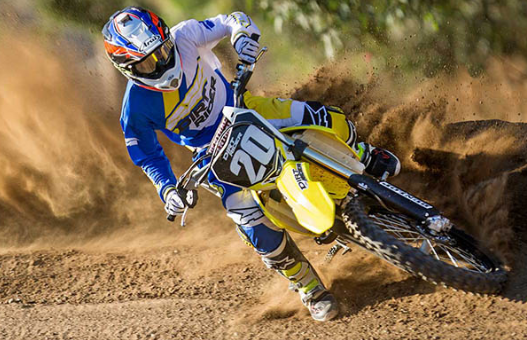Motocross has become an increasingly popular sport over the last number of years. With well-known brands such as GASGAS, KTM, Suzuki, Honda, Kawasaki and Yamaha motorcycles building impressive motocross models.
Whether you’re a riding novice keen to get your taste of adrenaline or you’re a seasoned professional, there are lots to learn about off-road riding, including the difference between 4 and 2-stroke motorcycles. So, before you get carried away with buying motocross gear, have a read of our guide and tips for buying 4 and 2-stroke off-road bikes below.
What’s a 2-stroke engine?
A ‘2-stroke’ motorcycle gets its name from power being created during ‘two strokes’ of the piston. The main features of a 2-stroke engine are compression and combustion. With every revolution of the crankshaft, the engine fires and ignites the spark plug, making this type of engine a lighter and louder motocross bike.
What’s a 4-stroke engine?
4-stroke motorcycles get their name from power being produced once every ‘four strokes’ of the piston. Unlike 2-stroke engines, 4-stroke bikes have four main features: intake, compression, combustion and exhaust. Firing every two revolutions of the crankshaft instead of one, 4-stroke engines have more predictable and controlled power output. Slightly heavier than 2-stroke engines, the design is also more complex due to the bike’s valve components.
What’s the difference between them?
An important differentiation to be aware of when buying 4-stroke and 2-stroke motorcycles is that a 2-stroke engine is equal to a higher cc version of a 4-stroke engine. For example, a 2-stroke 250cc has similar power capabilities to a 4-stroke Yamaha motorcycle of 450cc. With the majority of 4-stroke motorcycles on the market having high cc, this can make them a more expensive choice. While there are a number of differences between the two bikes, there’s still a healthy debate among motocross fans about which is better. It all boils down to personal preference, riding experience, handling, comfort and more. We take a look at some of the main things to consider below.
Establish your riding experience
Before buying any type of motorcycle, working out your riding experience and suitability for a bike is an integral part of the decision making process. It’s no different when buying a 4-stroke or 2-stroke motorcycle. There are a number of pros and cons to both options. While a 2-stroke is fast, light and agile, it’s also much harder to control, which can be daunting for beginners. There are a few things to concentrate on while riding a 2-stroke, and the rider needs to be experienced and confident enough to be able to manage the handling and frequent shifting.
The combination of smoother power in 4-stroke motorcycles makes it easy to ride and requires less effort and attention to detail, perfect for beginners who have yet to build up their confidence and experience. The controlled power means a rider doesn’t have to stress about repeated gear changes or consistent braking or clutching, making the ride far less overwhelming.
Decide what you want from your bike
As well as establishing your riding experience, deciding what you want from your bike is also an important factor before you purchase.
Think about how often you will use the bike, how much you’re willing to spend and how much you’ll use it to offset the cost. Because of two-stroke engines’ crankshafts needing lubrication, a mix of oil is regularly required in the air-fuel mixture this oil can add up for two-stroke bikes.
If you’ve got your heart set on a powerful machine, be sure to shop around when looking at 2-stroke options. Maximum power can sometimes be affected in 2-stroke engines due to exhaust gases getting trapped inside the combustion chamber, leading to improper combustion. Getting opinions from local motorbike dealers will help guide you on the best option for you.
Research motorcycle maintenance
When buying a motorcycle, what seems like an affordable deal initially, can quickly become an expensive one if hefty maintenance costs arise. That’s why it’s so important to do your homework before you buy. While it’s known that 4-stroke bikes burn less fuel and oil, their heavier body and additional parts often mean their parts are more expensive because there’s potentially more to fix. However, while 2-stroke parts are cheaper to buy, the need to replace them is usually more frequent, making it a more expensive option overall.
How will you use the bike?
Like any big purchase, establishing how you’re planning on using it will be a big deciding factor. 4-stroke motorcycles are more suitable for longer rides whereas the agility of a 2-stroke is perfectly matched for short sprints, manoeuvring around corners, climbing and riding up and down hilly areas. If you’re looking to go on longer dirt bike rides then the functionality of a 4-stroke is the best choice, however, if you’re an adrenaline junkie eager to race on short challenging tracks then the best option may be a 2-stroke motorcycle.
For a range of bikes motorcycles, motorcycle tyres and motocross gear visit the expert team at Peter Stevens















